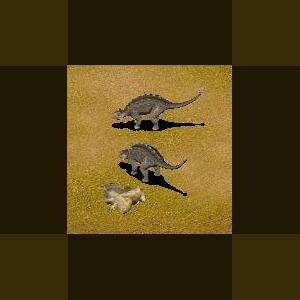About This File
Gargoyleosaurus parkpinorum ("gargoyle lizard") is both the smallest and the earliest known ankylosaur.
Its skull measures only 29 cm in length, and its total body length is an estimated three to four meters. It may have weighed as much as a tonne. The holotype was discovered at the Bone Cabin Quarry West locality, in Albany County, Wyoming in exposures of the Upper Jurassic (Kimmeridgian to Tithonian stages) Morrison Formation.
The next earliest known ankylosaur is Minmi paravertebrata from the Aptian stage in Queensland, Australia. The type species, G. parkpinorum (originally G. parkpini) was described by Ken Carpenter et al. in 1998. A mounted skeletal reconstruction of Gargoyleosaurus parkpinorum can be seen at the Denver Museum of Nature and Science.
The holotype specimen of Gargoyleosaurus parkpinorum was collected by Western Paleontology Labs in 1996 and is currently held in the collections of the Denver Museum of Nature and Science, Denver, Colorado. Besides the holotype, two other partial skeletons are known (although not yet described) The holotype consists of most of the skull and a partial postcranial skeleton. The specimen was originally described as Gargoyleosaurus parkpini by Carpenter, Miles and Cloward in 1998, then renamed G. parkpinorum by Carpenter et al. in 2001, in accordance with ICZN art. 31.1.2A.
Much of the skull and skeleton has been recovered, and the taxon displays cranial sculpturing, including pronounced deltoid quadratojugal and squamosal bosses. The taxon is further characterized by a narrow rostrum (in dorsal view), the presence of seven conical teeth in each premaxilla, an incomplete osseous nasal septum, a linerarly arranged nasal cavity, the absence of an osseus secondary palate, and, as regards osteoderms, two sets of co-ossified cervical plates and a number of elongate conical spines.



Recommended Comments
There are no comments to display.
Create an account or sign in to comment
You need to be a member in order to leave a comment
Create an account
Sign up for a new account in our community. It's easy!
Register a new accountSign in
Already have an account? Sign in here.
Sign In Now